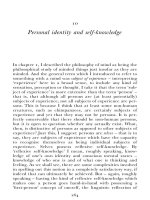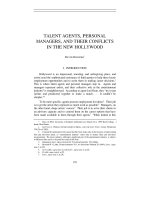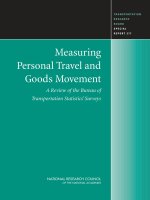Personal identity and self-knowledge
Bạn đang xem bản rút gọn của tài liệu. Xem và tải ngay bản đầy đủ của tài liệu tại đây (222.59 KB, 34 trang )
10
Personal identity and self-knowledge
In chapter 1, I described the philosophy of mind as being the
philosophical study of minded things just insofar as they are
minded. And the general term which I introduced to refer to
something with a mind was subject of experience – interpreting
‘experience’ here in a broad sense, to include any kind of
sensation, perception or thought. I take it that the term ‘sub-
ject of experience’ is more extensive than the term ‘person’ –
that is, that although all persons are (at least potentially)
subjects of experience, not all subjects of experience are per-
sons. This is because I think that at least some non-human
creatures, such as chimpanzees, are certainly subjects of
experience and yet that they may not be persons. It is per-
fectly conceivable that there should be non-human persons,
but it is open to question whether any actually exist. What,
then, is distinctive of persons as opposed to other subjects of
experience? Just this, I suggest: persons are selves – that is to
say, they are subjects of experience which have the capacity
to recognise themselves as being individual subjects of
experience. Selves possess reflexive self-knowledge. By
‘reflexive self-knowledge’ I mean, roughly speaking, know-
ledge of one’s own identity and conscious mental states –
knowledge of who one is and of what one is thinking and
feeling. As we shall see, there are some complexities involved
in spelling out this notion in a completely satisfactory way, if
indeed that can ultimately be achieved. But – again, roughly
speaking – having the kind of reflexive self-knowledge which
makes one a person goes hand-in-hand with possessing a
‘first-person’ concept of oneself, the linguistic reflection of
264
Personal identity and self-knowledge 265
which resides in an ability to use the word ‘I’ comprehend-
ingly to refer to oneself.
But what sort of thing does the word ‘I’ refer to, assuming
that it does indeed refer to something? What sort of thing
am I? In raising this question, of course, we return to some of
the issues discussed in chapter 2. There we saw that different
philosophers have offered very different answers to this ques-
tion, some holding that ‘I’ refers to a certain body – ‘my’
body – some that it refers to something altogether non-
physical, such as an immaterial soul or spirit, and some that
it refers to something which is a combination of body and
soul. Yet another possible answer is that ‘I’ refers to a collec-
tion of thoughts and feelings – ‘my’ thoughts and feelings.
But it may surprise us that philosophers can disagree so rad-
ically about what sort of thing ‘I’ refers to and yet be so
certain that it does refer to something. Perhaps we should
question that assumption. And even if we accept it, perhaps
we should question the assumption that ‘I’ refers to a thing
of the same sort or kind whenever it is used to refer to some-
thing. Perhaps persons or selves do not constitute a kind of
things, all instances of which share the same identity-
conditions. Perhaps to be a person or self is to occupy some
role or perform some function – a role or function which
could be occupied or performed by things of many different
kinds. For example, it might be held that being a person is a
role which my body occupies now and has occupied for most
of my existence, but that for the first few weeks or months
of my existence it did not occupy that role. This would imply
that, in my case at least, ‘I’ refers to my body, but that there
was a time when I (that is, my body) existed but was not
(yet) a person. We shall look more closely at this and other
possibilities in the course of this chapter.
Another set of issues which we should explore concerns our
knowledge of our own mental states and their content. How
is it that one can seem to have incontestable knowledge of
what one is thinking and feeling? Or is our belief that we
have such knowledge in fact unfounded? If so, we must still
explain the prevalence and tenacity of that belief. However,
An introduction to the philosophy of mind266
let us make a start with the phenomenon of self-reference,
that is, with the comprehending use of the word ‘I’.
THE FIRST PERSON
Although children pick up the use of the first-person pro-
noun, ‘I’, quite early in the course of their linguistic develop-
ment, understanding the semantics of first-person discourse
is a surprisingly difficult matter. It is easy enough to say what
the linguistic function of the word ‘I’ is, in a way which will
satisfy most people: ‘I’ is the word (in English) which every-
one uses to refer to him or herself. Every human language
appears to have a word or expression equivalent to this. But
the difficulty which philosophers have in understanding the
meaning of the word ‘I’ arises from the difficulty of spelling
out, in a non-circular and illuminating way, what it is to ‘refer
to oneself ’ in the special way that is associated with the com-
prehending use of the word ‘I’. I deliberately speak here of
the comprehending use of the word ‘I’, because, for instance,
even a mindless computer might be said to be ‘referring to
itself ’ when it displays some such message on its screen as ‘I
am ready’. Equally, a parrot could conceivably be taught to
utter the words ‘I feel hungry’ whenever it felt hungry, in
which case it might be said to be using the word ‘I’ to refer
to itself – but this wouldn’t imply that it had a first-person
concept of itself, as appears to be required for the compre-
hending use of the word ‘I’.
The difficulty that I am alluding to can perhaps best be
brought out by comparing the comprehending use of the
word ‘I’ to refer to oneself with the comprehending use of
various other singular terms to refer to oneself. I can, for
instance, use my personal name, ‘Jonathan Lowe’, to refer to
myself. Equally, I can use certain definite descriptions to
refer to myself, such as ‘the author of this book’ or ‘the
person seated in this chair’. However, it is a curious feature
of the word ‘I’ that it seems to be guaranteed to refer to a
quite specific person on any occasion of its use, in such a way
that the person using it cannot mistake which person it refers
Personal identity and self-knowledge 267
to – namely, him or herself. No such feature attaches to other
ways of referring to ourselves. I might forget that I am Jona-
than Lowe or come to doubt whether I am the author of this
book, but I cannot doubt that I am I. This might be dismissed
as a trivial matter, like the fact that I cannot doubt that
Jonathan Lowe is Jonathan Lowe. But that would be too quick
and superficial a response. That this is no trivial matter can
be brought out by considering the following kind of example.
Suppose that, upon entering a strange house and walking
along a corridor, I see a human figure approaching me and
form the following judgement: ‘That person looks suspicious’.
Then I suddenly realise that the person in question is myself,
seen reflected in a mirror at the end of the corridor.
Although, in one sense, I knew to whom I was referring in
using the demonstrative phrase ‘that person’ – namely, the
person who appeared to be approaching me – there is clearly
another sense in which I did not know to whom I was refer-
ring, since I was unwittingly referring to myself. Clearly,
then, when I ‘refer to myself ’ in the way involved in this
example, I do not refer to myself in the way I do when I use
the word ‘I’ – for in the latter case there is no similar possibil-
ity of my failing to know to whom I am referring.
This feature of the use of the word ‘I’ is closely linked with
the fact that certain first-person judgements exhibit what is
sometimes called ‘immunity to error through misidentifica-
tion’.
1
It is perfectly possible to make a mistaken first-person
judgement, of the form ‘I am F’, just as it is possible to make
a mistaken third-person judgement, of the form ‘S is F’. How-
ever, whereas ‘S is F’ can be mistaken in either of two differ-
ent ways, certain judgements of the form ‘I am F’ can appar-
ently be mistaken in only one way. Compare, for example,
1
The expression ‘immunity to error through misidentification’ is due to Sydney
Shoemaker: see his ‘Self-Reference and Self- Awareness’, Journal of Philosophy 65
(1968), pp. 555–67, reprinted in his Identity, Cause, and Mind: Philosophical Essays
(Cambridge: Cambridge University Press, 1984) and in Quassim Cassam (ed.),
Self-Knowledge (Oxford: Oxford University Press, 1994). The inspiration for this
notion comes from Ludwig Wittgenstein: see The Blue and Brown Books, 2nd edn
(Oxford: Blackwell, 1969), pp. 66ff. See also Gareth Evans, The Varieties of Refer-
ence (Oxford: Clarendon Press, 1982), pp. 179–91.
An introduction to the philosophy of mind268
the two judgements ‘John feels angry’ and ‘I feel angry’. In
making the first judgement, I might be mistaken either about
what John feels or about who feels angry. On the one hand,
perhaps John really feels jealous rather than angry. On the
other hand, perhaps it is not John who feels angry, but
another person whom I have mistaken for John. But now con-
sider the second judgement, ‘I feel angry’. Here, too, it is
possible for me to be mistaken about what I feel – maybe I
think I feel angry when really what I feel is jealousy. How-
ever, what doesn’t seem to make sense, in this case, is that I
should be mistaken not about what is felt but about who feels
it. It doesn’t seem to make sense that I should mistake
another person’s anger for my own. But not all first-person
judgements have this property of immunity to error through
misidentification: the only ones that do, it seems, involve the
attribution to oneself of some conscious psychological state.
Consider, for instance, the judgement ‘I am touching the
table with my hand’, made on the basis of what I can see and
feel. It is conceivable, if unlikely, that it is not in fact my
hand that is touching the table, but the very similar hand of
the person sitting next to me – and that what I can really
feel is my hand touching another nearby object. In that case,
I am mistaken about who is touching the table, in a way in
which I could not be mistaken about who is feeling angry
when I make the judgement ‘I feel angry’.
Some philosophers seem to think that, when the word ‘I’
is used as it is in making the judgement ‘I feel angry’, it
cannot really be functioning as a referring-expression at all,
precisely because mistaken reference is apparently ruled out in
such cases.
2
They take the view that a genuine act of refer-
ence to something can occur only if the possibility of mistake
or failure exists: as they might put it, where there is no pos-
sibility of failure, there is no possibility of success either.
2
For doubts about whether ‘I’ is a referring expression, see G. E. M. Anscombe,
‘The First Person’, in Samuel Guttenplan (ed.), Mind and Language (Oxford: Clar-
endon Press, 1975), reprinted in G. E. M. Anscombe, Metaphysics and the Philosophy
of Mind (Oxford: Blackwell, 1981). For discussion, see Andy Hamilton, ‘Anscomb-
ian and Cartesian Scepticism’, Philosophical Quarterly 41 (1991), pp. 39–54.
Personal identity and self-knowledge 269
Hence, they regard the word ‘I’ in such contexts as no more
having a referential function than the word ‘it’ has such a
function in a statement such as ‘It is raining’. So what, then,
is the function of the word ‘I’ in such contexts, according to
these philosophers? Here they are less clear, but they tend
to say that sentences like ‘I feel angry’ are used, in reality,
not so much to express judgements, which could be true or
false, as to make avowals. On this view, to say ‘I feel angry’ is
to express one’s feelings, rather than to express a judgement
about what one is feeling. Such an ‘avowal’ is regarded as a
verbal expression of emotion, comparable with such non-
verbal ‘expressions’ of emotion as angry looks and gestures.
3
However, most philosophers would, I think, be unper-
suaded by this doctrine, not least because they would not
subscribe to the principle that any genuine act of reference
must leave room for the possibility of error.
Furthermore,
they would regard it as being inherently implausible to sup-
pose that the same word, ‘I’, could have two radically differ-
ent functions. For that the word ‘I’ has a referential function
in many contexts of its use seems hardly disputable. How,
then, would these philosophers explain why the word ‘I’
seems incapable of reference-failure? Some of them may
attribute this quite simply to its being a so-called token-
reflexive expression, akin to such expressions as ‘here’ and
‘now’. Just as any utterance of the word ‘here’ standardly
refers to the place at which the word is uttered and any utter-
ance of the word ‘now’ standardly refers to the time at which
the word is uttered, so, on this account, any utterance of the
word ‘I’ standardly refers to the person who is uttering it.
Thus, the semantic rule governing the use of the word ‘I’
precludes the possibility of someone mistakenly using the
word ‘I’ to refer to anyone other than him or herself.
4
How-
3
In the Philosophical Investigations, Wittgenstein says at one point: ‘When I say ‘‘I
am in pain’’, I do not point to a person who is in pain ...Idon’t name any person.
Just as I don’t name anyone when I groan with pain. Though someone else sees
who is in pain from the groaning.’ See Ludwig Wittgenstein, Philosophical Investi-
gations, trans. G. E. M. Anscombe, 2nd edn (Oxford: Blackwell, 1958), p. 404.
4
For more on token-reflexivity and the comparison between ‘I’ and ‘now’, see
D. H. Mellor, ‘I and Now’, Proceedings of the Aristotelian Society 89 (1989), pp. 79–94,
An introduction to the philosophy of mind270
ever, although it is important to recognise the token-reflexive
character of the word ‘I’, it does not appear that appeal to
this alone can explain all the distinctive features of first-
person reference which we have been examining. This is
because one cannot capture what is special about the compre-
hending use of the word ‘I’ to refer to oneself merely by citing
the semantic rule that any utterance of the word ‘I’ stand-
ardly refers to the person uttering it. For that rule imposes
no requirement that the person – or, indeed, thing – uttering
the word ‘I’ should have a first-person conception of itself as
a self-aware subject of experience: and yet the compre-
hending use of the word ‘I’ to refer to oneself does require
this.
I have to confess that I know of no wholly satisfactory way
of providing a non-circular analysis of the concept of self-
reference which is peculiar to the comprehending use of the
word ‘I’. An ability to think of oneself as oneself and to attribute
to oneself, thought of in this way, various conscious thoughts
and feelings seems to be one which is primitive and irredu-
cible, in the sense that one cannot model this ability on any
other more general ability to think of particular objects and
attribute properties to them. At some stage in a normal
child’s intellectual development, it acquires this special abil-
ity, but how it achieves this must remain something of a mys-
tery so long as we have no way of characterising the ability
in question save in its own terms.
5
PERSONS AND CRITERIA OF IDENTITY
Given that the word ‘I’ is guaranteed a reference, on every
occasion of its comprehending use, to what sort of thing does
reprinted in his Matters of Metaphysics (Cambridge: Cambridge University Press,
1991). See also the papers in part I of Palle Yourgrau (ed.), Demonstratives
(Oxford: Oxford University Press, 1990) and John Campbell, Past, Space, and Self
(Cambridge, MA: MIT Press, 1994), ch. 3 and ch. 4.
5
For wide-ranging further discussion of the concept and development of self-
consciousness, from both philosophical and psychological perspectives, see Jose´
Luis Bermu
´
dez, Anthony Marcel and Naomi Eilan (eds.), The Body and the Self
Personal identity and self-knowledge 271
it refer when it is so used? The quick answer would be that
it refers to a particular person or self. But, as I have been using
the terms ‘person’ and ‘self ’, this is effectively just true by
definition and so not especially revealing – for I have charac-
terised a person as being a subject of experience which has
a first-person concept of itself. We have not yet established
that either persons, or subjects of experience more generally,
constitute a distinct sort or kind of things in the way, say,
that stars, oak trees and chairs all constitute distinct kinds
of things. The instances of a genuine sort or kind must at
least share the same identity-conditions, enabling us to count
such instances and trace their careers over time. If someone
asks me how many oak trees there are in a certain wood at
a certain time, I know, at least in principle, how to discover
the answer to that question, because I know what makes one
oak tree numerically distinct from another at a given
moment of time – namely, the fact that it occupies a distinct
and separate region of space of a shape apt to accommodate
just one oak tree. Likewise, if someone asks me whether the
oak tree now growing in a certain part of the wood is the same
oak tree as the one which was growing there forty years ago,
I know, at least in principle, how to discover the answer to
this question, because I understand the persistence-conditions of
oak trees – that is, I understand what sorts of changes an oak
tree can and cannot undergo if it is to survive over time. For
instance, I know that oak trees can survive transplantation
and hence that it would be rash to assume that this oak tree
is identical with a previously encountered one merely because
it has the right sort of age and is growing in the same place.
The question that we must ask now is whether subjects of
experience, and more specifically persons, do indeed constitute
a genuine kind of things, all instances of which share the
same identity-conditions, enabling us to count persons and
trace their careers over time. On the face of it, the answer
(Cambridge, MA: MIT Press, 1995). See also Jose´ Luis Bermu
´
dez, The Paradox of
Self-Consciousness (Cambridge, MA: MIT Press, 1998).
An introduction to the philosophy of mind272
to this question is clearly ‘Yes’. We seem to assume that we
can count persons at least as easily as we can count oak trees
and that persons have persistence-conditions determining
what sorts of changes they can and cannot undergo if they
are to survive over time. It may be that we are a little unclear
about what to say in certain borderline cases, but the same
is true as regards oak trees, which we none the less consider
to constitute a genuine and indeed natural kind of things.
So what are the principles which govern how we count per-
sons and trace their careers over time? What we are looking
for, here, is what many philosophers would call a criterion of
personal identity.
6
The general form which a criterion of iden-
tity for things of a kind K takes is this:
(C
k
)Ifx and y are things of kind K, then x is identical with
y if and only if x and y stand in the relation R
k
to one
another.
So the question that we must try to answer is this: how do a
person P
1
and a person P
2
have to be related to one another
if P
1
is to be identical with P
2
? The problem has two aspects –
one concerning the identity of persons at a time (‘synchronic’
identity) and the other concerning the identity of persons over
time (‘diachronic’ identity) – the second of which is usually
regarded as the more difficult. Clearly, there are many trivial
and uninformative answers to the question that has just been
raised. It would be true, but only trivially so, to say that P
1
and P
2
must be related by identity if they are to be identical
with one another. What is sought is a non-trivial and inform-
ative answer to the question in hand. More generally, the
relation R
k
mentioned in a criterion of identity of the form
of (C
k
) must not be the relation of identity itself, nor any
relation which can only be stated in terms which involve or
presuppose the identity of things of kind K.
6
For more on the general notion of a criterion of identity, see my ‘What Is a
Criterion of Identity?’, Philosophical Quarterly 39 (1989), pp. 1–21, reprinted in
Harold W. Noonan (ed.), Identity (Aldershot: Dartmouth, 1993) and my ‘Objects
and Criteria of Identity’, in Bob Hale and Crispin Wright (eds.), A Companion to
the Philosophy of Language (Oxford: Blackwell, 1997).
Personal identity and self-knowledge 273
Some philosophers have maintained that persons have a
bodily criterion of identity. For instance, some have main-
tained that a person P
1
and a person P
2
are identical, either
at a time or over time, if and only if P
1
and P
2
have the same
body. Against this, it may be pointed out that persons can
survive the loss of many parts of their bodies. However, this
is not a decisive consideration, since it is equally plausible to
say that a person’s body can survive the loss of many of its
parts. A more compelling objection, if it can be sustained,
would be that different persons can share the same body – as
is sometimes alleged to happen in cases of so-called multiple
personality syndrome – or that one person can swap bodies
with another.
7
The latter possibility is suggested by the seem-
ingly feasible but as yet unattempted procedure of whole-
brain transplantation, whereby the brain of one person is
transplanted into the skull of another and vice versa. In the
light of this apparent possibility, some philosophers are
inclined to judge that it is sameness of brain, rather than
sameness of body, which makes for personal identity. How-
ever, such a position would appear to be unstable, for the
following reason (even setting aside any problem raised by
cases of multiple personality syndrome, in which the same
brain appears to be shared by two different people). Clearly,
the reason why we are inclined to judge that a double brain-
transplant operation would constitute a swapping of bodies
between two people rather than a swapping of their brains is
that we suppose all the vitally important aspects of human
personality to be grounded in features of the brain – in par-
ticular, we suppose a person’s memories and temperament
to be grounded in features of his or her brain. But this sug-
gests that what we really take to determine a person’s identity
are these aspects of human personality and, consequently,
that we should deem it possible, at least in principle, for a
person to acquire a new brain, provided that the new brain
7
For a discussion of the implications of multiple personality syndrome, see
Kathleen V. Wilkes, Real People: Personal Identity Without Thought Experiments
(Oxford: Clarendon Press, 1988), ch. 4.
An introduction to the philosophy of mind274
serves to ground all the vital aspects of human personality
which were grounded by the old one.
8
We have been led, by a couple of plausible steps, from a
bodily criterion of personal identity, via a brain criterion, to a
psychological criterion of personal identity. According to simple
versions of the latter type of criterion, a person P
1
and a
person P
2
are identical, either at a time or over time, if and
only if P
1
and P
2
share certain allegedly vital aspects of
human personality. But what are these allegedly vital aspects
of human personality? Are there, in fact, any aspects of one’s
personality which cannot change over time? It seems hard to
suppose so. People can undergo radical changes of tempera-
ment following brain injury and they can suffer extreme
forms of amnesia or memory-loss. However, while we may
agree that someone’s personality may, over an extended
period of time, become completely altered, it is less obvious
that someone could survive a sudden and radical change of
personality, involving both a complete change of tempera-
ment and a wholesale exchange of ‘old’ memories for ‘new’
ones. This would seem to be more a case of one person repla-
cing another than a case of one and the same person surviving
a change. So perhaps an acceptable psychological criterion
of personal identity should allow a person to undergo major
changes of personality over time, but only if these changes
take place in a piecemeal and gradual fashion. For example,
according to such an approach, a person existing at one time
might retain none of the memories possessed by that same
person at a much earlier time, provided that at the later of
any two intervening times separated by only a short interval,
he retained many of the memories which he possessed at the
earlier of those two times.
9
8
For further discussion of the implications for personal identity of brain-
transplantation and related procedures, see Sydney Shoemaker, Self-Knowledge and
Self-Identity (Ithaca, NY: Cornell University Press, 1963), pp. 22ff and Bernard
Williams, ‘The Self and the Future’, Philosophical Review 79 (1970), pp. 161–80,
reprinted in his Problems of the Self (Cambridge: Cambridge University Press,
1973).
9
For more on this idea of continuity of memory, see Derek Parfit, Reasons and Persons
(Oxford: Clarendon Press, 1984), pp. 204ff.
Personal identity and self-knowledge 275
However, even this more plausible version of a psycholo-
gical criterion of personal identity is subject to an apparently
devastating objection. For if we suppose that the aspects of
human personality which are relevant to personal identity,
such as temperament and memory, are grounded in features
of the brain, what is to rule out the possibility of two different
brains simultaneously grounding the same aspects of human
personality? Suppose, for example, that the two hemispheres
of a single brain both grounded the same aspects of human
personality – the same temperament and memories – but
were then separated and transplanted into the skulls of two
different human bodies, each of which had previously had its
own brain removed.
10
Then, it seems, we would be confronted
with two different human persons, each with only half a
brain, sharing the same temperament and memories. But
this seems to be incompatible with the suggested psycholo-
gical criterion of personal identity, which implies that per-
sons who share the same temperament and memories are
identical. What we seem to be faced with here is a case of
personal fission – the splitting of one person, P
1
, into two dis-
tinct persons, P
2
and P
3
. The logical laws of identity preclude
us from saying that P
2
and P
3
are both identical with P
1
, since
they are not identical with each other. And yet both P
2
and P
3
are related psychologically to P
1
in a way which the proposed
psychological criterion of personal identity deems to be suffi-
cient for identity. Accordingly, it seems, that criterion must
be mistaken.
One possible response to this objection is to revise the pro-
posed psychological criterion of personal identity in such a
way that a person existing at a later time qualifies as ident-
10
The more general implications for the concept of personal identity of the possibil-
ity of brain-bisection are discussed by Thomas Nagel in his ‘Brain Bisection and
the Unity of Consciousness’, Synthese 22 (1971), pp. 396–413, reprinted in his
Mortal Questions (Cambridge: Cambridge University Press, 1979). The hypothet-
ical case of brain-bisection followed by separate transplantation of the two hemi-
spheres is discussed by Derek Parfit in his ‘Personal Identity’, Philosophical Review
80 (1971), pp. 3–27, reprinted in Jonathan Glover (ed.), The Philosophy of Mind
(Oxford: Oxford University Press, 1976). See also Parfit, Reasons and Persons, ch.
12.
An introduction to the philosophy of mind276
ical with a person existing at an earlier time only if no pro-
cess of fission has occurred, that is, only if the person existing
at the later time is the only person existing at that time who
is related in the relevant psychological way to the person
existing at the earlier time. However, if this line of response
is adopted, it seems to have the implication that questions of
personal identity are far less important, morally and emo-
tionally, than we intuitively take them to be.
11
For, according
to this view, whether or not I shall still exist tomorrow may
depend on the answer to the seemingly unimportant question
of whether or not someone else very similar to me will exist
tomorrow. If I am destined to undergo fission, I shall cease
to exist: and yet someone else will exist tomorrow who is
related to me psychologically in just the same way in which
I am related to my self of yesterday. Indeed, two such people
will exist tomorrow. However, if what matters to me when I
consider my own prospects for survival is simply that some-
one should exist tomorrow who is related to me psychologic-
ally in the same way in which I am related to my self of
yesterday, why should I worry if more than one such person
exists tomorrow? But if I shouldn’t worry about this, then it
follows, according to the view of personal identity now being
proposed, that I shouldn’t necessarily worry about there not
existing anyone tomorrow who is identical with me. Indeed,
perhaps I shouldn’t think of my ‘survival’ in terms of identity –
that is, in terms of there existing in the future someone who
will be identical with me – but rather in terms of there being
at least one (but possibly more than one) person existing in
the future who will be related to me psychologically in the
way in which I am related to my past self. On this under-
standing of ‘survival’, if I undergo fission I shall ‘survive’
twice over, even though no one existing after the fission will
be identical with me.
The upshot of our discussion so far is that we have not
found a criterion of personal identity, either bodily or psycho-
11
This is Derek Parfit’s view, who also suggests the notion of ‘survival’ shortly to
be discussed: see again his Reasons and Persons, ch. 12 and ch. 13.









